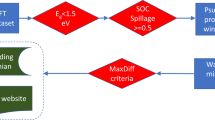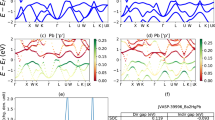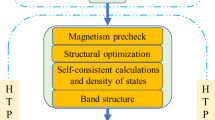Abstract
Recently, many high-throughput calculation materials databases have been constructed and found wide applications. However, a database is only useful if its content is reliable and sufficiently accurate. It is thus of paramount importance to gauge the reliabilities and accuracies of these databases. Although many properties have been predicted accurately in these databases, electronic band gap is well known to be underestimated by traditional density functional theory (DFT) calculations under local density approximation (LDA), which becomes a challenging problem for materials database building. Here, we introduce MaterialGo (http://www.pkusam.com/data-base.html), a new database calculating the band structures of crystals using both Perdew-Burke-Ernzerhof (PBE) exchange-correlation functional and Heyd-Scuseria-Ernzerhof (HSE) hybrid functional}. {tiComparing different PBE databases, it is found that their band gaps are consistent when no U parameter is used for transition metal d-state or heavy element f-state to correct their self-interaction error, but rather different when PBE+U are used, mostly because of the different values of U used in different database. HSE calculations under standard parameters will give larger band gaps that are closer to experiment. Based on the high-throughput HSE calculations over 10000 crystal structures, we might have a better understanding of the relationship between crystal structures and electronic structures, which will help us to further explore material genome science and engineering.
Similar content being viewed by others
References
Pilania G, Gubernatis J E, Lookman T. Multi-fidelity machine learning models for accurate bandgap predictions of solids. Comput Mater Sci, 2017, 129: 156–163
de Jong M, Chen W, Notestine R, et al. A statistical learning framework for materials science: Application to elastic moduli of k-nary inorganic Polycrystalline Compounds. Sci Rep, 2016, 6: 34256
Morales-García Á, Valero R, Illas F. An empirical, yet practical way to predict the band gap in solids by using density functional band structure calculations. J Phys Chem C, 2017, 121: 18862–18866
Belsky A, Hellenbrandt M, Karen V L, et al. New developments in the inorganic crystal structure database (ICSD): Accessibility in support of materials research and design. Acta Cryst Sect A Found Cryst, 2002, 58: 364–369
Bergerhoff G, Hundt R, Sievers R, et al. The inorganic crystal structure data base. J Chem Inf Model, 1983, 23: 66–69
Downs R T, Hall-Wallace M. The american mineralogist crystal structure database. Am Mineral, 2003, 88: 247–250
Pizzi G, Cepellotti A, Sabatini R, et al. AiiDA: Automated interactive infrastructure and database for computational science. Comput Mater Sci, 2016, 111: 218–230
Jain A, Hautier G, Moore C J, et al. A high-throughput infrastructure for density functional theory calculations. Comput Mater Sci, 2011, 50: 2295–2310
Jain A, Ong S P, Hautier G, et al. Commentary: The materials project: A materials genome approach to accelerating materials innovation. APL Mater, 2013, 1: 011002
Curtarolo S, Setyawan W, Hart G L W, et al. AFLOW: An automatic framework for high-throughput materials discovery. Comput Mater Sci, 2012, 58: 218–226
Calderon C E, Plata J J, Toher C, et al. The AFLOW standard for highthroughput materials science calculations. Comput Mater Sci, 2015, 108: 233–238
Curtarolo S, Setyawan W, Shi Dongwang, et al. AFLOWLIB.ORG: A distributed materials properties repository from high-throughput ab initio calculations. Comput Mater Sci, 2012, 58: 227–235
Saal J E, Kirklin S, Aykol M, et al. Materials design and discovery with high-throughput density functional theory: The open quantum materials database (OQMD). JOM, 2013, 65: 1501–1509
Liu Y, Zhao T, Ju W, et al. Materials discovery and design using machine learning. J Materiomics, 2017, 3: 159–177
Liu Y, Zhao T, Yang G, et al. The onset temperature (Tg) of As Se1 glasses transition prediction: A comparison of topological and regression analysis methods. Comput Mater Sci, 2017, 140: 315–321
Shi S Q, Gao J, Liu Y, et al. Multi-scale computation methods: Their applications in lithium-ion battery research and development. Chin Phys B, 2016, 25: 018212
Wang Y, Zhang W, Chen L, et al. Quantitative description on structure-property relationships of Li-ion battery materials for highthroughput computations. Sci Tech Adv Mater, 2017, 18: 134–146
Perdew J P, Burke K, Ernzerhof M. Generalized gradient approximation made simple. Phys Rev Lett, 1996, 77: 3865–3868
Heyd J, Scuseria G E, Ernzerhof M. Hybrid functionals based on a screened coulomb potential. J Chem Phys, 2003, 118: 8207–8215
Shockley W, Queisser H J. Detailed balance limit of efficiency of p-n junction solar cells. J Appl Phys, 1961, 32: 510–519
Adjokatse S, Fang H H, Loi M A. Broadly tunable metal halide perovskites for solid-state light-emission applications. Mater Today, 2017, 20: 413–424
Lucero M J, Henderson T M, Scuseria G E. Improved semiconductor lattice parameters and band gaps from a middle-range screened hybrid exchange functional. J Phys-Condens Matter, 2012, 24: 145504
Moussa J E, Schultz P A, Chelikowsky J R. Analysis of the heydscuseria- ernzerhof density functional parameter space. J Chem Phys, 2012, 136: 204117
Jia W, Fu J, Cao Z, et al. Fast plane wave density functional theory molecular dynamics calculations on multi-GPU machines. J Comput Phys, 2013, 251: 102–115
Jia W, Cao Z, Wang L, et al. The analysis of a plane wave pseudopotential density functional theory code on a GPU machine. Comput Phys Commun, 2013, 184: 9–18
Hamann D R. Optimized norm-conserving vanderbilt pseudopotentials. Phys Rev B, 2013, 88: 085117
Schlipf M, Gygi F. Optimization algorithm for the generation of ONCV pseudopotentials. Comput Phys Commun, 2015, 196: 36–44
Lin L. Adaptively compressed exchange operator. J Chem Theor Comput, 2016, 12: 2242–2249
Krukau A V, Vydrov O A, Izmaylov A F, et al. Influence of the exchange screening parameter on the performance of screened hybrid functionals. J Chem Phys, 2006, 125: 224106
Heyd J, Peralta J E, Scuseria G E, et al. Energy band gaps and lattice parameters evaluated with the heyd-scuseria-ernzerhof screened hybrid functional. J Chem Phys, 2005, 123: 174101
Lee B, Wang L W, Spataru C D, et al. Nonlocal exchange correlation in screened-exchange density functional methods. Phys Rev B, 2007, 76: 245114
Hybertsen M S, Louie S G. Electron correlation in semiconductors and insulators: Band gaps and quasiparticle energies. Phys Rev B, 1986, 34: 5390–5413
Ma J, Wang L W. Using Wannier functions to improve solid band gap predictions in density functional theory. Sci Rep, 2016, 6: 24924
Weng M, Li S, Ma J, et al. Wannier koopman method calculations of the band gaps of alkali halides. Appl Phys Lett, 2017, 111: 054101
Weng M, Li S, Zheng J, et al. Wannier koopmans method calculations of 2D material band gaps. J Phys Chem Lett, 2018, 9: 281–285
Li S, Weng M, Jie J, et al. Wannier-koopmans method calculations of organic molecule crystal band gaps. Europhys Lett, 2018, 123
Author information
Authors and Affiliations
Corresponding authors
Electronic supplementary material
11431_2019_9514_MOESM1_ESM.doc
A new MaterialGo database and its comparison with other high-throughput electronic structure databases for their predicted energy band gaps
Rights and permissions
About this article
Cite this article
Jie, J., Weng, M., Li, S. et al. A new MaterialGo database and its comparison with other high-throughput electronic structure databases for their predicted energy band gaps. Sci. China Technol. Sci. 62, 1423–1430 (2019). https://doi.org/10.1007/s11431-019-9514-5
Received:
Accepted:
Published:
Issue Date:
DOI: https://doi.org/10.1007/s11431-019-9514-5




